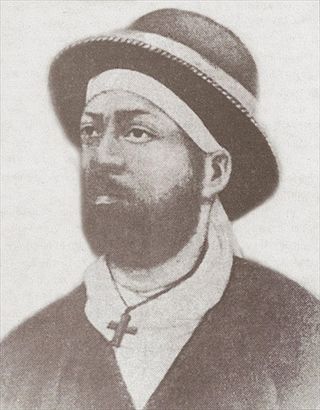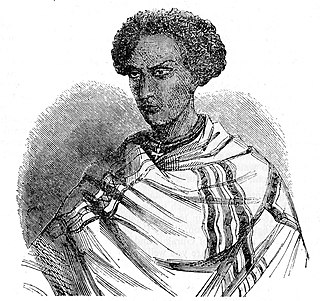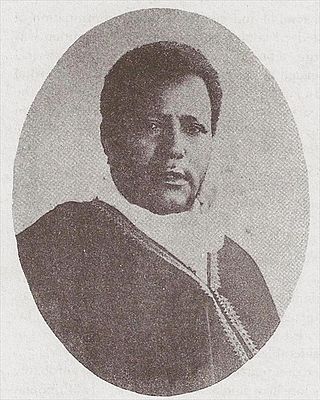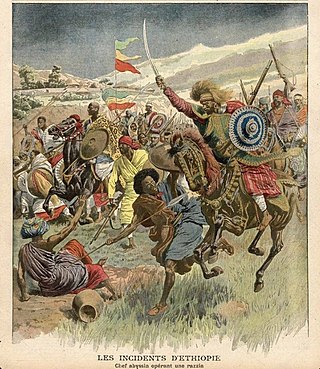Genealogy from Tegulet
| Emperor Eskender r. 1478-1494 [2] | |||||||||||||||||||||||
| Woyzero Marta | Aläm-Säggäd | ||||||||||||||||||||||
| Gǎbră-Şeyon | Wālāttā-Sara | ||||||||||||||||||||||
Garmame [note 1] (b. ca. 1808/09/10 - 22 March 1900) [note 2] and Horse name: Abba Mala was an influential 19th century Ethiopian military commander, provincial governor and royal counsellor serving under Negus Sahle Selassie, Haile Melekot and Emperor Menelik II. He held the title of Dejazmach. Garmame is remembered for his leading role in rescuing Menelik II and other notables from captivity in July 1865, and restoring the Shewan heir back to the throne. In May 1877 he prevented a coup concocted by Bafena, and solidified the position of his Negus. After retirement from military activities, Garmame governed large tracts of fertile land south of Ankober, and is also remembered for his role in providing relief to the people during the disastrous 1890's famine'. [1] [2]
Garmame was born in Tegulet [4]
Sources are contradictory about the identity of his parents. One version by a Catholic missionary; Guglielmo Massaia, said that Garmame was a natural son of King Sahle Selassie of Shewa. According to this version, Garmame would have been the first son of Sahle Selassie, and not Haile Melekot (presumably his much younger half brother). [2]
A second version by Garmame's chronicler; Qenazmach Hayle, said Garmame was the illegitimate son of Wossen Seged, making him a younger brother of Sahle Selassie. Garmame was born during Wossen Seged's reign. [2]
A third version is that he was the son of Walda Hawaryat [note 3] , and Betesanabatan of Tegulet. Walda Hawaryat descended from the Shewan nobility and his genealogy claimed to trace back to the Solomonic Emperor Eskender. Whatever version is the correct one, Garmame was very closely associated with the Shewan ruling family since at least the 1840s. [2]
Garmame's first (military) role of significance occurred in the aftermath of King Sahle Selassie's death. He is said to have been in service of Haile Melekot when King Sahle Selassie was still alive. On the death of the latter, the Oromos of Shewa rose in open revolt. He advised the new king, Haile Melekot, not to lead the military expedition himself, and took the task upon him to put down the rebellion. Garmame skillfully divided the Oromo chiefs, and days later led a victorious military campaign as far as Nazret. Thus, Garmame along with the two princes Darge Sahle Selassie and Sayfu Sahle Selassie played a major role in stabilizing Haile Melekot's new administration. [2] [6]
Since his military feat, until his death (except for the period Tewodros II conquered Shewa between 1855-1865), Garmame governed the region of the Awash Valley, from his seat at Debre Gojo, southwest of Ankober and Tegulet. [2]
Garmame was instrumental in the escape of Shewan royal family, most notably Menelik II, and other notable political prisoners of Tewodros II. Garmame managed to feign loyalty to Tewodros and even been given the hand of Qataro Merso, [note 4] whom he suspected was a spy for Tewodros. Garmame was the intermediary between secret correspondence between Menelik II and his loyal followers back in Shewa. To avoid any leaks of secrets, Garmame pretended to be ill, and moved his bed from house to house to one or other of his loyal friends at Tewodros II's camp. Oblivious, his wife Qataro sent all the people her husband told her who were knowledgeable of medicine to him, when in reality they were Garmame's secret agents. [5]
In July 1865, crafty Garmame threw a feast and invited his friends, and the guards of the fortress gate to eat and drink at his house. He acted in the manner of a most generous host and saw to it that everyone, including his wife, had an abundance of liquor. After midnight, when everyone was intoxicated and asleep, Garmame led Menelik II and twenty other Shewans through the unguarded gates, and escaped the fortress. By dawn, the fugitives, on horses purchased in advance by Garmame's agents, had reached Werqitu's camp in Wollo some kilometers to the south. After replenishing their strength, they left for Shewa on the third day. [2] [5]
In 1877 before leaving Shewa for a military campaign in Gojjam, Menelik had entrusted the administration of Shewa to Azzaj Wolda Tsadeq and Dejazmach Garmame. Bafena inspired rebellion through Haile Mikael Sahle Selassie took them by surprise, and the aged noble took control of Ankober on May 2, 1877, proclaiming himself as the Negus of Shewa. Two days later, Garmame supported by Afe Negus Madhane restored order by defeating Haile Mikael's forces in battle. Haile Mikael was wounded, captured and imprisoned at Ankober. [3]
On 15 May however, the sly Bafena convinced Menelik to make her regent in his absence, and came into possession of his royal seal that authorized her above Garmame and Wolda Tsadeq, and took control of the strategic fortress of Tamo, and plotted her next coup attempt. [3]
Unlike many of his peers, Garmame preferred landed property and the cultivation and storage of grain to anything else. During the great famine of 1888-1892, he was the only notable governor who could supplement the depleted granaries of the imperial palace. [4]
He died of illness and was buried at the Lalibala church cemetery of Qacama around 1899 or 1900. [4] [1]
| Emperor Eskender r. 1478-1494 [2] | |||||||||||||||||||||||
| Woyzero Marta | Aläm-Säggäd | ||||||||||||||||||||||
| Gǎbră-Şeyon | Wālāttā-Sara | ||||||||||||||||||||||

Menelik II, baptised as Sahle Maryam was King of Shewa from 1866 to 1889 and Emperor of Ethiopia from 1889 to his death in 1913. At the height of his internal power and external prestige, the process of territorial expansion and creation of the modern empire-state was completed by 1898.

RasMakonnen Wolde Mikael Wolde Melekot, or simply Ras Makonnen, also known as Abba Qagnew, was an Ethiopian royal from Shewa, a military leader, the governor of Harar, and the father of future Emperor Haile Selassie. Described by Nikolai Gumilev as “one of the greatest leaders of Abyssinia”, he served in the First Italo-Ethiopian War, playing a key role at the Battle of Adwa. Ras Makonnen was commonly referred to as “the Napoleon of Africa”.
Ankober, formerly known as Ankobar, is a town in central Ethiopia. Located in the North Shewa Zone of the Amhara Region, it's perched on the eastern escarpment of the Ethiopian Highlands at an elevation of about 2,465 meters (8,100 ft). It is 40 kilometers (25 mi) to the east of Debre Birhan and about 90 miles (140 km) northeast of Addis Ababa.

The Solomonic dynasty, also known as the House of Solomon, was the ruling dynasty of the Ethiopian Empire from the thirteenth to twentieth centuries. The dynasty was founded by Yekuno Amlak, who overthrew the Zagwe dynasty in 1270. His successors claimed he was descended from the legendary king Menelik I, the supposed son of the biblical King Solomon and the Queen of Sheba, in order to legitimize the dynasty's assumption of power. Although this claimed ancestry gave the dynasty its name, there is no credible evidence that the dynasty was descended from Solomon or the Davidic line. The Solomonic dynasty remained in power until 1974, when its last emperor Haile Selassie was overthrown by a coup d'état.

Haile Malakot was Negus of Shewa, a historical region of Ethiopia, from 12 October 1847 until his death. He was the oldest son of Negus Sahle Selassie an important Amhara noblemen and his wife Woizero Bezabish Wolde.
Nagasi Krestos was the ruling prince of Shewa, an important Amhara noble of Ethiopia. Nagasi succeeded to unite fragmented Amhara districts in Shewa, and launched several wars of reconquest of Shewan territories against his Oromo enemies.

Sahle Selassie was a ruler and later King of Shewa from 1813 to 1847. An important Amhara noble of Ethiopia, he was a younger son of Wossen Seged. Sahle Selassie was the father of numerous sons, among them Haile Melekot, Haile Mikael, Seyfe Sahle Selassie, Amarkegne and Darge Sahle Selassie; his daughters included Tenagnework, Ayahilush, Wossenyelesh, Birkinesh, and Tinfelesh.
Woizero Bezabish Wolde was the wife of Sahle Selassie, Negus of Shewa, mother of King Haile Melekot of Shewa, and grandmother of Emperor Menelik II. She held the districts of Bulga and Yifat as her personal fiefs. Bezabish would become infamous for betraying her son Haile Melekot by submitting to his opponent Emperor Tewodros II during the latter's forcible re-incorporation of Shewa under the direct rule of the Imperial throne in 1855.
Woizero Zenebework was the wife of Wossen Seged, Merid Azmach of Shewa; the mother of Negus Sahle Selassie, the first Negus of Shewa; the grandmother of Negus Haile Melekot of Shewa; and the great-grandmother of Emperor Menelik II. Woizero Zenebework held the powerful districts of Menz and Tegulet as her personal fiefs.

Darge Sahle Selassie Horse name Abba Gersa was a 19th-century Ethiopian nobleman, provincial governor, general and a trusted councillor of his nephew Emperor Menelik II.
Sela Dingay is a town in central Ethiopia. In Amharic the name means the sharpened stone, named for a rock which rolled over the edge of the southern rim of the gorge of the Mofar River, and killed a group of people sitting on it. Located in the Semien Shewa Zone of the Amhara Region, this town has a latitude and longitude of 09°58′N39°38′E with elevations variously given as 2880 and 2915 meters above sea level. It is the administrative center of Mojana Wadera woreda.

FitawrariHabte Giyorgis Dinagde also known by his horse name Abba Mechal was an Ethiopian military commander and government official who, among several other posts, served as President of the Council of Ministers and as Minister of War during the reigns of Menelik II, Zewditu and Haile Selassie. He was also Shum or Governor of Borena, Ibat, and Mecha.
Leul Sagad Atnaf Sagad, also known by his horse name Abba Balay, was an Ethiopian courtier and army commander (Ras) under Emperor Menelik II. A key figure in late 19th and early 20th century, he was responsible for several successful military campaigns, but was killed in battle during the struggle over Menelik's succession.

Wube Haile Maryam of Semien, (1799-1867), also called by his title Dejazmach Wube, Webé; his name is also given in European sources as ‘‘Ubie’’. Wube was one of the major figures of 19th century Ethiopia, during the closing decades of the Zemene Mesafint a period of regional lords vying for power, prestige and territory amid a weakened authority of the emperors.
Shum TembienMercha Wolde Kidan was the ruler of Tembien, a province of Tigray, and father of Kasa Mercha. Mercha had his seat at Melfa in the mountainous Degwa Tembien. Due to his connections to the leading families of Tigray, he was regarded as one of the first nobles of the region. He himself, however, never acquired a central position within the Ethiopian power structure, but transmitted his own claims for rulership to his descendants.
The Battle of Azule was fought on 6 September 1886, between the forces of Ras Darge Sahle Selassie of Shewa and a force of Arsi Oromo. It was part of a broader series of expansion campaigns done under Menelik II, Negus of Shewa, referred to by some historians as the Agar Maqnat. The battle of Azule was important as it represents the crushing of a large Arsi army by one under Menelik; it also demonstrates the dynamic of gun-wielding Shewans fighting Spear-wielding Arsi that many historians like to stress when discussing Menelik's expansions; it also retains symbolic and historic importance in the politics and identities of many.

Menelik's Expansions, also known as the Agar Maqnat, was a series of wars and conquests carried out by Menelik II of Shewa to expand the Ethiopian Empire.
Bafena Wolde Mikael or beter known as just Bafena (1834-1887) was the second wife of Menelik II then the King of Shewa. She was described as ‘‘attractive, vivacious and ambitious’’ and is remembered for her failed conspiracy against her husband, in a attempted coup plot in 1877.
Bashah Aboye horse name: Abba Däffar, was a distinguished Ethiopian military commander under Emperor Menelik II, and governor of several former principalities and regions in the south. Bashah died fighting the Italians during the Battle of Adwa.

Welde Giyorgis Aboye was one of the most prominent Ethiopian generals who spearheaded Emperor Menelik's southward expansion at the close of the 19th century. His fame soared after leading the conquest on the Kingdom of Kaffa as a Ras, and was subsequently appointed as provincial governor of that fief by the Emperor. Welde Giyorgis later became the governor of Begemder. A few months before his death, he was elevated to Negus, of Gondar by Empress Zewditu in 1917, as recognition for his role in deposing Lij Iyasu.
{{cite book}}: |work= ignored (help)